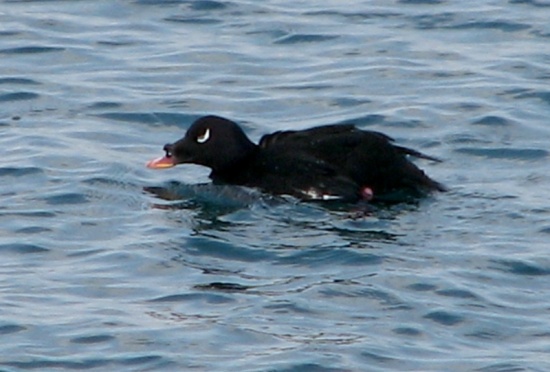Alternate name: Siberian Scoter
- Melanitta stejnegeri
Identification
Length 51-58cm (20-22¾ in), weight 1200-1800 g
Male
- Black overall plumage
- White 'tick' just below and behind the eye
- Long yellow bill
- Thick neck
- Pointed tail
Female
- Dusky brown upperparts
- Scaly-looking brownish-grey underparts
- Two pale spots in the head, one on the auriculars, one between eye and bill
Juvenile a paler version of female
Notes on distinguishing males of White-winged Scoter, Velvet Scoter, and Stejneger's Scoter
- Velvet Scoter (M. fusca): the least knob on the bill, and the least white around and behind the eye; almost no white above the eye. The coloured section of the bill is yellow and relatively long, and the distance from the base of that to the eye is short, producing the impression that the eye is positioned relatively far forward on the head. The crown looks highest above the eye.
- White-winged Scoter (M. deglandi): clear knob at the base of the bill, with the yellow-orange part relatively short, so that the eye looks set further back on head than Velvet Scoter. The white around the eye is shaped as a checkmark, pointed up at the rear end. The coloured part of the bill is orange with the top parts looking yellow. The crown is highest in front of the eye. When seen well, flanks will be brown in contrast to black back and breast.
- Stejneger's Scoter (M. stejnegeri): Head shape closer to Common Eider in shape, with a long, sloping forehead. White around eye similar to or longer than White-winged Scoter. It has a clear knob - almost like a small Rhinoceros horn - on the bill, further forward than M. deglandi, and the coloured parts are mostly red with yellow "lipstick" below. Flanks are black
Females are much harder to distinguish, only determinable at the closest range; Velvet Scoter has a slightly concave forehead with no basal swelling on the bill, Stejneger's Scoter has a slightly swollen bill base, and White-winged Scoter a marginally more swollen bill base.
Distribution
Breeds in northeast Asia; winters in coastal East Asia to Japan and China. Accidental to Western Alaska; and to Europe.
Taxonomy
This is a monotypic species[1]. Formerly considered a race of White-winged Scoter
Habitat
Breeds around small freshwater bodies of water in boreal forest and Arctic tundra. Winters mostly at sea in shallow waters.
Behaviour
Diet
Mainly molluscs, crustaceans, worms, echinoderms, annelids, and small fish. In fresh water, also takes insects and their larvae. Forages by diving using both wings and feet.
Breeding
Nest is shallow depression on the ground, lined with plant matter and down. Clutch is 6–9 creamy-buff or yellowish-white eggs incubated by the female.
Vocalisation
Usually silent but males reported to give two-parted whistled and low nasal calls. Female gives gruff croaking notes.
Movements
Migratory; winters on coasts of northeast Asia south to Japan and eastern China; also inland. Prior to leaving breeding grounds, those in East Asia mass off the Okhotsk coast with smaller numbers on lakes in Kamchatka and on Sakhalin.
References
- Clements, J. F., T. S. Schulenberg, M. J. Iliff, S. M. Billerman, T. A. Fredericks, B. L. Sullivan, and C. L. Wood. 2019. The eBird/Clements Checklist of Birds of the World: v2019. Downloaded from http://www.birds.cornell.edu/clementschecklist/download/
- del Hoyo, J., N. Collar, and G. M. Kirwan (2020). Stejneger's Scoter (Melanitta stejnegeri), version 1.0. In Birds of the World (J. del Hoyo, A. Elliott, J. Sargatal, D. A. Christie, and E. de Juana, Editors). Cornell Lab of Ornithology, Ithaca, NY, USA. https://doi.org/10.2173/bow.whwsco1.01
- del Hoyo, J., Collar, N. & Kirwan, G.M. (2020). Siberian Scoter (Melanitta stejnegeri). In: del Hoyo, J., Elliott, A., Sargatal, J., Christie, D.A. & de Juana, E. (eds.). Handbook of the Birds of the World Alive. Lynx Edicions, Barcelona. (retrieved from https://www.hbw.com/node/467113 on 8 April 2020).
- Dunn, J. L., D. G. Gibson, M. J. Iliff, G. H. Rosenberg, and K. J. Zimmer (2012). Alaska records of the Asian White-winged Scoter. Western Birds 43:220–228. PDF
- Garner, M., Lewington, I., and Rosenberg, G. 2004. Stejneger’s Scoter in the western Palearctic and North America. Birding World 17:337–347.
- Garner, M. (2011) Birding Frontiers Stejneger's and White-winged Scoters
Recommended Citation
- BirdForum Opus contributors. (2025) Stejneger's Scoter. In: BirdForum, the forum for wild birds and birding. Retrieved 26 April 2025 from https://www.birdforum.net/opus/Stejneger%27s_Scoter
External Links
GSearch checked for 2020 platform.1




